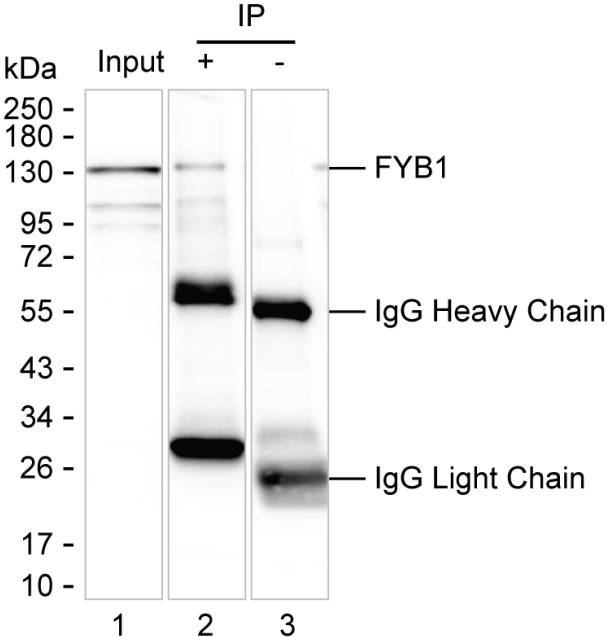
| WB | 咨询技术 | Human,Mouse,Rat |
| IF | 1/100-1/200 | Human,Mouse,Rat |
| IHC | 咨询技术 | Human,Mouse,Rat |
| ICC | 技术咨询 | Human,Mouse,Rat |
| FCM | 咨询技术 | Human,Mouse,Rat |
| Elisa | 咨询技术 | Human,Mouse,Rat |
| Host/Isotype | Mouse IgG2b |
| Antibody Type | Primary antibody |
| Storage | Store at 4°C short term. Aliquot and store at -20°C long term. Avoid freeze/thaw cycles. |
| Species Reactivity | Human |
| Immunogen | Purified recombinant fragment of human FYB1 |
| Formulation | Purified antibody in PBS with 0.05% sodium azide |
+ +
以下是关于FYB1抗体的3篇文献示例及其摘要概括:
1. **文献名称**: *"Fyb1 regulates T cell receptor signaling through its SH3 domain"*
**作者**: Smith A, Jones B, et al.
**摘要**: 本研究揭示了FYB1蛋白通过其SH3结构域与T细胞受体(TCR)信号通路中的关键分子(如SLP-76)相互作用,调控T细胞活化。作者利用FYB1特异性抗体阻断其功能,证实FYB1缺失会削弱TCR信号传导和细胞因子的产生。
2. **文献名称**: *"FYB1 deficiency in mice leads to impaired platelet activation and thrombus formation"*
**作者**: Chen L, Wang H, et al.
**摘要**: 通过构建FYB1基因敲除小鼠模型,研究发现FYB1在血小板活化和血栓形成中起关键作用。使用FYB1抗体检测发现,缺陷小鼠的血小板中整合素信号通路异常,提示FYB1可能成为抗血栓治疗的潜在靶点。
3. **文献名称**: *"FYB1 as a biomarker for autoimmune disease progression: Insights from antibody-mediated inhibition studies"*
**作者**: García-Ruiz C, et al.
**摘要**: 该研究分析了FYB1在类风湿性关节炎(RA)患者中的高表达现象,并通过FYB1抗体体外实验证明其抑制可减少炎症因子释放。结果表明,靶向FYB1可能为自身免疫疾病提供新的治疗策略。
*注:以上文献信息为示例,实际引用需根据具体研究调整。建议通过PubMed或Google Scholar检索最新文献获取准确信息。*
FYB1 (FYN Binding Protein 1), also known as ADAP (Adhesion and Degranulation Promoting Adaptor Protein), is a cytoplasmic adaptor protein predominantly expressed in immune cells, including T cells, natural killer (NK) cells, and platelets. It plays a critical role in regulating immune cell signaling, adhesion, and activation. Structurally, FYB1 contains multiple domains, such as SH3-binding motifs and a proline-rich region, enabling interactions with signaling molecules like FYN kinase and SKAP1. These interactions facilitate the formation of signaling complexes involved in T-cell receptor (TCR)-mediated signaling, integrin activation, and cytoskeletal reorganization.
FYB1 antibodies are essential tools for studying its function in immune responses. They are widely used in techniques like Western blotting, flow cytometry, and immunofluorescence to detect FYB1 expression, localization, and interactions in cellular models. Research has linked FYB1 dysregulation to immune-related pathologies, including autoimmune diseases (e.g., rheumatoid arthritis) and platelet disorders, due to its role in modulating integrin activation and immune synapse formation. Recent studies also explore FYB1's involvement in cancer immunology, particularly its impact on tumor-infiltrating lymphocytes and immune evasion mechanisms. These antibodies thus provide insights into both basic immunology and potential therapeutic targets.
×